31 July 2015
O'Donovan Rossa's funeral
Funeral report from 'The Irish Volunteer' newspaper, 7 August 1915
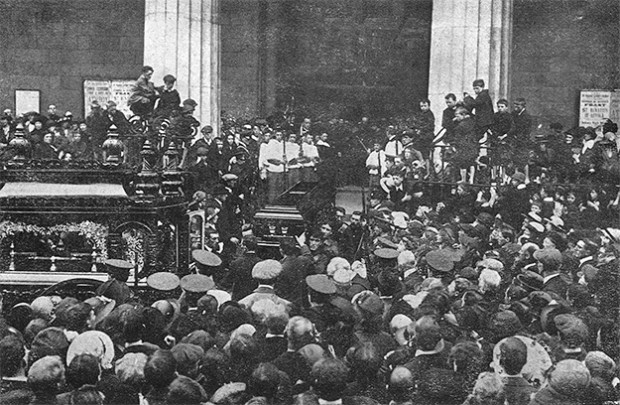
• Leaving the Pro-Cathedral
The coffin was conveyed from the City Hall to the four-horse bier in waiting at 2:25pm and, 15 minutes later, the cortege started, headed by a guard of honour of the Irish Volunteers with rifles, a mounted guard being supplied by the same body.
THE PUBLIC FUNERAL of Jeremiah O'Donovan Rossa took place on Sunday afternoon from the City Hall, Dublin, to Glasnevin Cemetery.
During the three days when they lay in the vestibule of the City Hall the remains, which were encased in a coffin with a plate glass lid, exposing the features to view, were visited by thousands of citizens.
The public funeral yesterday, as a pageant, was remarkably well organised and was carried through without a hitch.
This duty devolved on the officers of the Irish Volunteers. Thomas MacDonagh acted as Commandant-General; Mr Daly was in charge of the military bodies, which included the Irish Volunteers, the National Volunteers, and the Dublin “Citizen Army”. This was the first occasion in which these three bodies have united in one public procession.
The nationalist societies of Dublin, which were well represented, were in charge of O'Rahilly, and Mr Joseph Plunkett was in charge of the delegations.
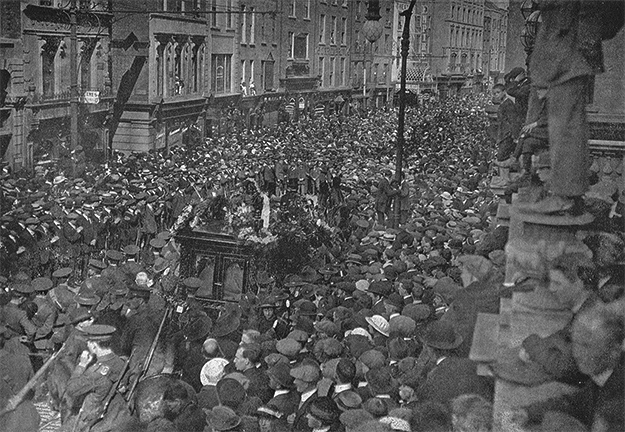
• Passing through Dame Street
THE STREET PROCESSION
The coffin was conveyed from the City Hall to the four-horse bier in waiting at 2:25pm and, 15 minutes later, the cortege started, headed by a guard of honour of the Irish Volunteers with rifles, a mounted guard being supplied by the same body.
The coffin was thickly covered with wreaths, and an open carriage behind was also filled with floral tokens, whilst many of the contingents carried wreaths to be placed on the grave.
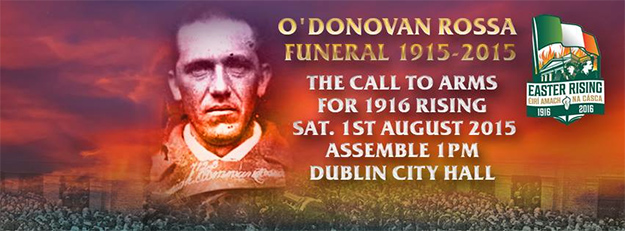
Immediately following the bier were a number of old friends of the deceased, including some from America, Liverpool, Cork, and representatives of the urban council of his native town of Skibbereen. Following were carriages containing the widow and daughter, some clergymen, and representatives of various public bodies.
Immediately following these came Irish Volunteers with arms reversed; the National Volunteers, who were allotted a position about the middle of the procession, did not carry any arms. Contingents of Volunteers; as well as the representatives of the. several trade societies and branches of the GAA, INF [Irish National Foresters], etc, were headed by their own bands, who. played the “Dead March” when the signal for starting was given, but subsequently marching airs were played through the. Streets.
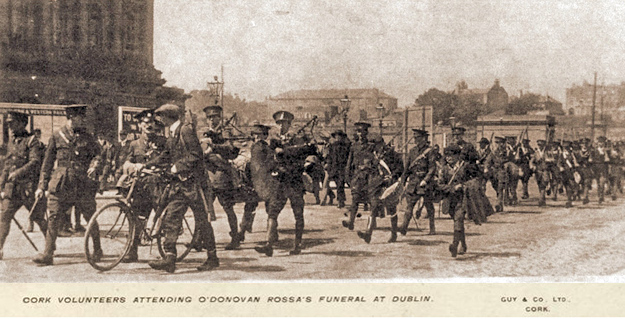
The procession, marching four deep at a slow pace, took a little over 50 minutes to pass the comer of Dame Street into George's Street, and there was no delay in marshalling any of the contingents.
A conservative estimate of those who actually took part in the procession gives the numbers as exceeding ten thousand, and there must have been at least ten times this number lining the streets.
The funeral came into College Green about 3 o'clock, headed by a body of Volunteers, with the St James's Band.
To describe its passing this historic point is to describe the even tenor of its way to Glasnevin Cemetery. There was no rise or fall of grief in the procession. The slow music of the bands sounded forth. The Volunteers, with arms reversed, paced slowly to its strains, company after company.
Apart from the great number of Volunteers, the procession was remarkably long, taking an hour to pass any point.
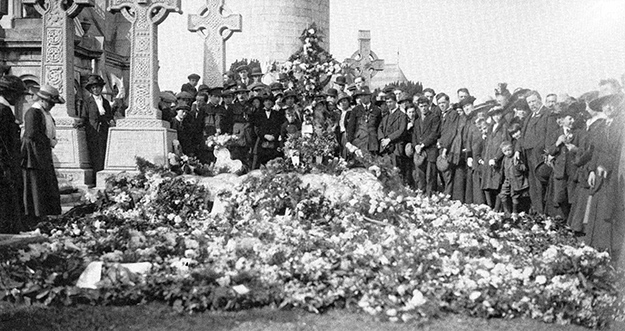
• Floral tributes
AT GLASNEVIN
It was nearing 6 o'clock when the hearse passed through the main gates of Glasnevin Cemetery. The avenue leading to the mortuary chapel was lined by detachments of Volunteers. The prayers in the chapel were said by the Rev D. Byrne, Chaplain.
Several priests then accompanied the coffin to the grave, which is situated just beyond the eastern fringe of the O'Connell Circle, close to the graves of two other prominent Fenians, John O'Leary and James Stephens. The burial service was recited in Irish by the Rev Father O'Flanagan, Sligo.
Mr P. H. Pearse delivered a panegyric on O'Donovan Rossa. He said that he spoke on behalf of a new generation that has been rebaptised in the Fenian faith and had accepted the responsibility of carrying out the Fenian programme.
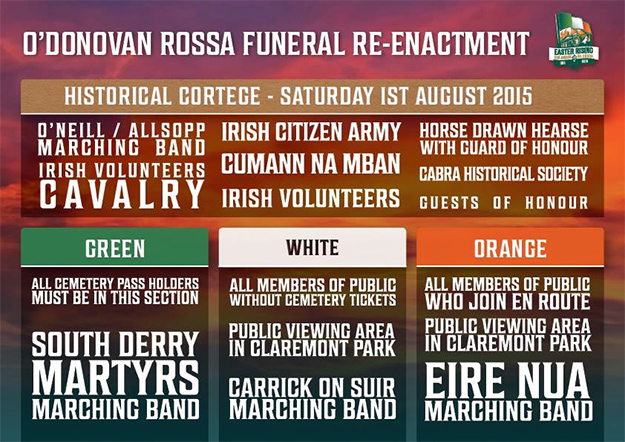
He proposed that by the grave of that unrepentant Fenian they should renew their baptismal vows. Deliberately they avowed themselves, as O'Donovan avowed himself in the dock, Irishmen of one allegiance only.
The Irish Volunteers and others associated with them in the day's task and duty, were bound together henceforth in brotherly union for the achievement of the freedom of Ireland. They knew only one definition of freedom: it was the definition of Tone, Mitchel and Rossa.
In a closer spiritual communion with Rossa, and with those who suffered with him in English prisons, and with their own comrades of the present day who were now suffering in English prisons, they around Rossa's grave pledged to Ireland their love and to English rule in Ireland their hate.
Their foes were strong, wise, and wary, but still they could not undo the miracles of God who ripened in the hearts of young men the seeds sown by the young men of a former generation. The seeds sown by the young men of '65 and '67 were coming to their miraculous ripening today. Rulers and defenders of realms had need to be wary if they would guard against such processes. The defenders of this realm had worked well in secret and in the open.
They thought that they had pacified. Ireland, and purchased half of them and intimidated the other half. They thought that they had foreseen everything, but the fools had left to them their Fenian dead, and while Ireland held those graves Ireland unfree would never be at peace.
A firing party then fired a volley, The Last Post was sounded, and wreaths were laid on the grave.
It is estimated that at least five thousand rifles were carried in the procession.
O’Donovan Rossa Funeral Committee, 1915
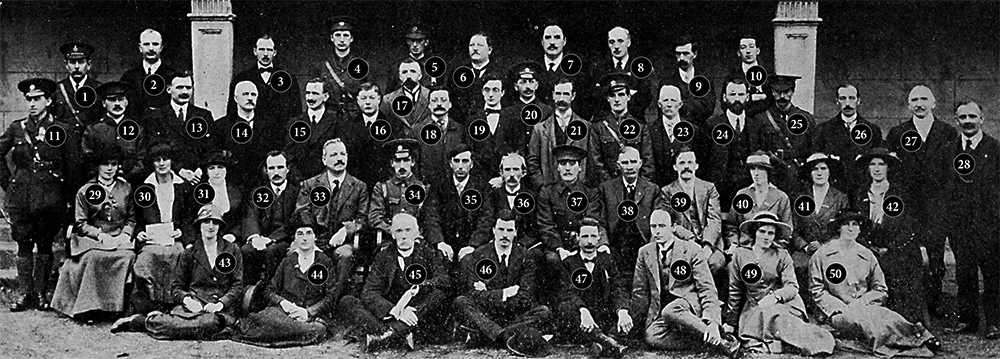
Back Row:1 J. K. O’Reilly, 2 P. T. Keohane, 3 Diarmuid Lynch, 4 Commandant Éamon de Valera, 5 James Tobin, 6 B. R. Parsons, 7 John O’Mahony, 8 W. O’Leary Curtis, 9 John Larkin, 10 William Cullen.
Second Row: 11 Commandant-General Thomas MacDonagh, 12 Martin Conlon, 13 J. J. O’Kelly (Sceilg), 14 James Casey, 15 Councillor Richard O’Carroll, 16 J. Farren, (Treasurer, Dublin Trades Council), 17 Seamus Buggy, 18 Arthur Griffith, 19 Seán MacGadhra, 20 Joseph McGuinness, 21 Joseph Murray, 22 Henry Nicholls, (B.A., B.A.I), 23 J. Lawlor, (Vice-President, Dublin Trades Council), 24 William O’Brien, (Ex-President, Dublin Trades Council), 25 Cathal Brugha, 26 James Whelan, 27 Major John MacBride, 28 T. Farren, (President, Dublin Trades Council).
Third Row: 29 Miss J. Walsh, 30 Constance Markievicz, 31 Mrs. C. Holohan, 32 Bhathair Ó Foghludha, 33 John R. Reynolds, (F.A.A), 34 Commandant Eamonn Daly, 35 Seamus Ó Conchubhair, 36 Thomas J. Clarke, 37 Peadar McNally, 38 James Stritch, 39 Michael Slater, 40 Mrs. Tom Clarke, 41 Miss S. MacMahon, 42 Miss B. Cassidy.
Fourth Row : 43 Máire Ní Raghnaill, 44 Mrs. C. O’Moore, 45 Michael McGinn, 46 Thomas Meldon, 47 Joseph Kelly, 48 Brian O’Higgins, (Brian Na Banban), 49 Miss B. Walsh, 50 Mrs. Joseph McGuinness.


